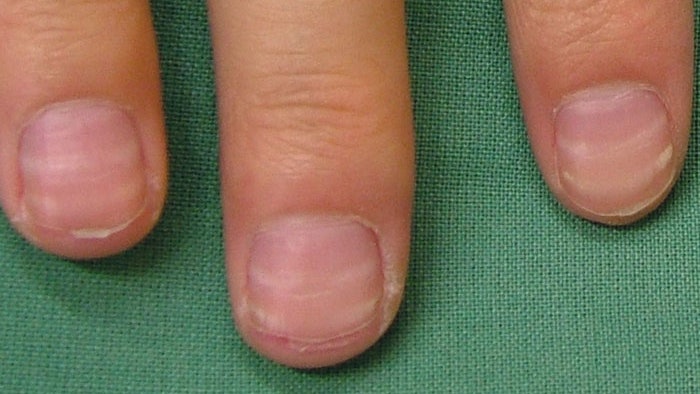
You’ve probably heard that nails are a reflection of your overall health.
Nail condition is so important, in fact, that the authors of a 2015 study noted that because even subtle nail abnormalities can indicate systemic diseases, dermatologists should examine the nails during every routine visit.
As a nail tech, you’ve likely seen nails that are weak or break easily, dotted with white spots or wavy with ridges. But what if you notice thin, white horizontal lines across the nails? It could be Beau’s lines, a fairly common occurrence that’s usually the telltale sign of other issues in the body, such as chronic illness, injury or a reaction to medication. Here’s what you should know about Beau’s lines.
Identifying Beau’s Lines
First described by 19th century French physician Joseph Honoré Simon Beau, Beau’s lines are often described as depressions or grooves in the fingernails or toenails. Most of the time, however, they look like a line across the nail.
“It’s not so much a ridge, but actually a change in the nail plate,” says Grace Torres Hodges, DPM, a podiatry fellow with the Council on Nail Disorders and an American Podiatric Medical Association spokesperson in Pensacola, Florida. “Typically, if you feel the nail plate, it’s smooth. It almost looks like you scratched the nail on something.”
Janet McCormick, author, salon and spa educator and cofounder of the Nailcare Academy in Fort Myers, Florida, also points out that Beau’s lines are unlikely to occur on just one nail. “Beau’s lines are a systemic thing, and clients who have it tend to have it to some degree on every nail,” she explains.
Although Beau’s lines are common, it’s easy to misidentify them, according to McCormick and Hodges. A client who has psoriasis, for example, might have nails that appear scooped or folded, which sometimes looks like Beau’s lines, but psoriasis more commonly causes pitting in nails (although some patients will have both). Habit tics, a nail deformity that results from habitual picking or pushing back of the cuticle, usually occur only on the thumb and are often quite deep.
Appearances really are everything when it comes to Beau’s lines, Hodges says, because they aren’t a “condition” per se, but rather a “symptom” reflective of something else going on in the body. “It’s really a description of the nail,” she says. “There isn’t one thing associated with it.”
What Causes Beau’s Lines?
Like all of the body’s tissues, the ones that make up the nail bed need oxygen to grow and function properly. An injury (incurred during a manicure or by dropping something on a toe), nutritional deficiency, some metabolic conditions and chemotherapy inhibit healthy blood flow, consequently reducing the amount of oxygen getting to the tissue. That reduction in healthy blood flow produces various effects, including hair loss (from chemotherapy treatments, for example) and Beau’s lines on the nails, which are farthest away from the heart.
The most common cause of Beau’s lines is infection of the cuticle, known as paronychia, explains Joshua Zeichner, MD, director of cosmetic and clinical research in dermatology at Mount Sinai Hospital in New York. “They can also be related to systemic diseases, such as thyroid disease, heart disease and psoriasis, which can affect the growth of skin, as nails are part of the dermatological system,” says Hodges. A deficiency in iron or zinc or overall malnutrition can also lead to the development of Beau’s lines. “Nails grow like a kid or plant—if you don’t feed them, they don’t grow properly,” says Hodges.
Another analogy doctors use to help people understand Beau’s lines is to think of them like the rings on a tree stump. “The rings of a tree signify a specific period of time,” says Zeichner. Because nails only grow 0.1 millimeter per day, doctors can figure out what the cause might be by pinpointing when the disruption in nail development took place. “Beau’s lines are indentations in the nails that develop because of some sort of temporary disruption in the production of the nails,” says Zeichner.
Servicing Clients With Beau’s Lines
Although Beau’s lines can be associated with some serious health problems, they’re not contagious in any way. Nail techs shouldn’t try to diagnose the problem, stresses McCormick; instead, they should recommend that clients ask their doctor about the nail abnormality if they aren’t already aware of it.
While typical manicure and pedicure services should be fine for clients with Beau’s lines, Zeichner suggests refraining from being aggressive with cuticles, which can increase the risk of infection. A couple of coats of nude polish should be enough to make Beau’s lines undetectable, says McCormick. If clients are concerned about their Beau’s lines, however, it’s best to recommend they see a doctor for a diagnosis before covering the nails with gel polish or other enhancements. “Doctors need to see the lines to determine how long ago the matrix was affected and whether the lines could be because of an injury, for example,” says McCormick, who once developed Beau’s lines herself due to a thyroid condition.
There’s no specific treatment for Beau’s lines; most often, they grow out on their own. “It’s common to find them, and they’ll go away if the factors affecting the condition are managed,” says Hodges.
The Missing Link
Common causes of Beau’s lines include bacterial infections, thyroid conditions or heart disease. Other conditions linked to Beau’s lines: diabetes, high fever, liver disease, malaria and measles.
This story first appeared in the February 2019 issue of Nailpro magazine.











